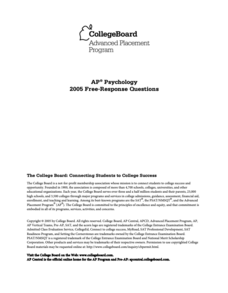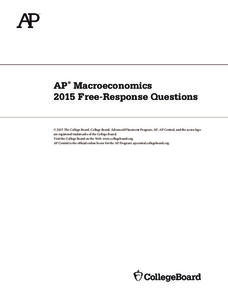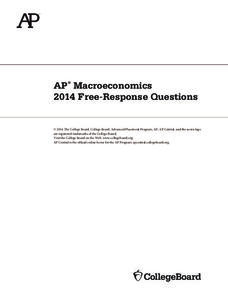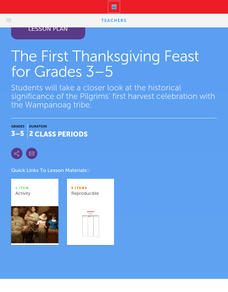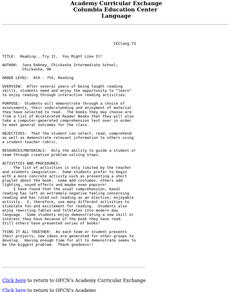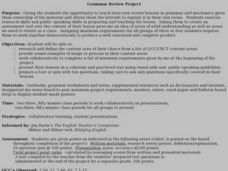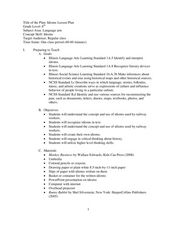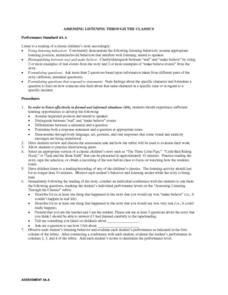College Board
2003 AP® Psychology Free-Response Questions
Intelligence testing can be a useful tool—but what are its limits? Scholars explore the question, considering issues such as the role of bias, using authentic College Board materials. Learners also examine the psychological factors...
College Board
2005 AP® Psychology Free-Response Questions
How can diagnostic labels help children? Is hypnosis a useful tool or a fraudulent practice? An examination prompt explores controversies in psychology. A second, structured inquiry unpacks perception—and its various influences.
College Board
2005 AP® Macroeconomics Free-Response Questions Form B
Suppose a country increases its budget deficit. How would such an increase affect businesses and the exchange rate? Learners consider what happens and ponder other questions from College Board that look at employment, supply and demand,...
College Board
2015 AP® Macroeconomics Free-Response Questions
Currency exchange is a big factor in governments making economic decisions. Scholars consider various scenarios to evaluate how factors such as interest rates and private investments would affect a nation's economy using a practice test...
College Board
2014 AP® Macroeconomics Free-Response Questions
What is the role of the Federal Reserve? Scholars consider how the bank works behind the scenes of the economy using authentic College Board materials. Other questions consider the impact of inflation on trade with a friendly partner and...
College Board
2001 AP® Human Geography Free-Response Questions
The green revolution has changed agricultural practices, but its success may be limited. Learners consider why as they use authentic College Board materials. Other prompts explore the rise of suburbs and the stages of economic development.
College Board
2003 AP® Statistics Free-Response Questions Form B
Update the statistics in your course using older AP® questions. The 2003 AP® Statistics free-response questions cover several of the concepts in the current statistics standards for all pupils. Items contain questions about...
EngageNY
Grade 11 ELA Module 2: Unit 1, Lesson 14
Leave the past in the past. Scholars read paragraph 12 of the chapter "Of Our Spiritual Strivings" to analyze Du Bois's development of gaining liberty and leaving the ideas of the past. Pupils then carry out a three to five-minute...
Radford University
How to Calculate and Analyze the Equation for a Parabolic Path
Working in groups, pupils plot three points on the coordinate plane representing three different parabolic paths. Using a calculator, they determine the quadratic regression equation for their models. Each team then figures out the...
Scholastic
The First Thanksgiving Feast for Grades 3-5
Scholars examine the first Thanksgiving through books and interviews while they complete a KWL chart. Pretending they are part of the feast, learners craft a scrapbook page that features images related to their experience. Pupils reflect...
EngageNY
Making a Claim: Moon Shadow’s Point of View of the Immediate Aftermath
Body paragraphs are the building blocks of every essay. Pupils view and discuss a model essay using a rubric to evaluate one of its supporting paragraphs. Next, scholars use what they've learned to continue drafting their own literary...
Crabtree Publishing
Why Does Media Literacy Matter?
Criticism of news and entertainment journalism is at an all-time high. Help 21st-century learners develop the media literacy skills they need to become critical consumers with a three-lesson guide the looks at persuasive techniques used...
Bonneville
Simple Solar Tracker
Let the solar cells fight each other for supremacy! Given a functional solar tracker that moves toward light, groups copy the design to build their own devices. They use two sets of solar cells that have reverse polarization, so that the...
Utah Education Network (UEN)
Statistics
Find the value in analyzing data values. Statistics is the focus in the fifth of seven installments of the 6th Grade Math series. Individuals learn to examine dot plots, histograms, and box plots by considering the shape, mean, median,...
Simon & Schuster
Classroom Activities for The Odyssey by Homer
A 15-page packet details three activities designed to engage scholars in Homer's The Odyssey. As they read, pupils use a graphic organizer to record examples of several literary terms found in The Odyssey and contemporary...
K20 LEARN
Criminal Motivations: Irony and Characterization In "The Cask Of Amontillado"
Edgar Allan Poe's short story "The Cask of Amontillado" is a bit of a puzzle. Critics have long debated Montresor's motives for killing Fortunato. Young scholars examine examples of the three types of irony (verbal, dramatic, and...
Curated OER
What is Good Writing
Students identify the qualities of good writing. For this writing lesson, students use the 6+1 Traits of Writing and use a rubric to discuss samples of writing on the overhead. Students discuss the strengths and weaknesses of each...
Curated OER
Following Directions Using Magic Tricks
Students recreate magic tricks in an effort to follow directions. They evaluate the clarity of their instructions and teach an apprentice how to perform a trick. They are evaluated using a rubric to note the clarity of their directions...
Curated OER
How Did I Do?
In this self evaluation worksheet, students use the rubric to grade themselves on a 4-3-2-1 scale. The rubric covers following directions, written work, pictures and effort.
Curated OER
Creating an Autobiography
Young scholars create technology based portfolios for others to use as a pattern for assessment. They make a "Personal Autobiography Page" to start the portfolio.
Curated OER
Reading...Try It, You Might Like It!
Students demonstrate through a choice of assessments, their understanding and enjoyment of materials they select to read.
Curated OER
Grammar Review Project
Students design an review and design an assessment for a grammar and usage unit.
Curated OER
Idioms Lesson Plan
Sixth graders discover idioms. In this idioms activity, 6th graders evaluate idioms and discover their meaning. Students read Runny Babbit by Shel Silverstein and create unique idioms. Assessment rubric is provided.
Curated OER
ASSESSING LISTENING THROUGH THE CLASSICS
Students demonstrate listening behaviors. They assume appropriate listening position, minimize/avoid behaviors that interfere with listening, and attend to speaker. They distinguish between real and make believe and cite 2 or more...
Other popular searches
- Self Assessment Rubrics
- Art Assessment Rubrics
- Science Assessment Rubrics
- Portfolio Assessment Rubrics
- Reading Assessment Rubrics
- Writing Assessment Rubrics
- Project Assessment Rubrics
- Assessment Rubrics for Maps
- Assessment Rubrics for Mapd
- Assessment Rubrics for Ma Pd
- Music Assessment Rubrics



